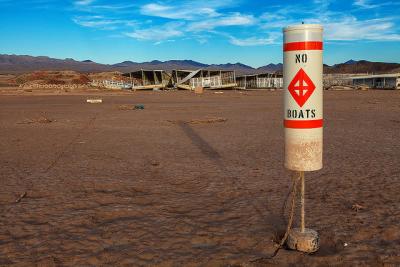The Business Argument for Addressing Climate Change
PhD, Conflict Analysis and Resolution, George Mason University
M.A, Conflict Transformation & Peacebuilding, Eastern Mennonite University
 |
 Most Americans know, in general, about climate change. Even those who dispute it have read or heard about rising tides, melting ice caps and superstorms.
Most Americans know, in general, about climate change. Even those who dispute it have read or heard about rising tides, melting ice caps and superstorms.
However, the American people remain largely unaware of how climate change will potentially affect our economy. This week’s release of a report by the Risky Business Project, “From Boom to Bust? Climate Risk in the Golden State,” timed with the California governor’s historic announcement of mandatory water restrictions, warned that Golden State businesses, communities, natural environments, infrastructure and agriculture industries are set to be devastated by sea-level rise, heat waves, decreasing precipitation, more extreme weather and frequent wildfires.
California produces nearly two-thirds of the nation’s fruits and nuts, a third of its vegetables and a fifth of its dairy products. Global warming is rapidly making the state hotter and drier. As one of the world’s top 10 economies, if California fails to adapt to its four-year-and-counting drought, the impact at home, nationally and across the globe will be serious and substantial.
While California is in desperate need of additional water supply, the April 1 snowpack measurements were lower than ever before (5 percent of historic average). California’s Department of Water Resources minced no words in noting the “meager” snowfall. Snow is already melting up to 30 days earlier than it was several decades ago.
The long-term solution is to reduce our dependence on fossil fuels. We can start by ensuring the fiscal 2016 budget helps low income families install and get the benefits from solar energy. We can also incentivize manufacturers to produce more efficient consumer devices such as smartphones and tablets. These measures to increase efficiency and expand deployment of renewables, along with the historic increase in fuel economy put in place by President Barack Obama and other reductions in usage, would help.
We also need to ensure that our children are aware of all the consequences of global warming. Let’s create a program in the National Oceanic and Atmospheric Administration to broaden the understanding of human-induced climate change, the possible long- and short-term consequences, and potential solutions.
We need to act today. The threats multiply the longer we wait. It’s estimated that in just 35 years, nearly $10 billion worth of California property will be underwater, with another $10 billion at risk during high tide. By 2100, nearly $20 billion of California’s coastal property will likely be consumed by rising sea levels. The Bay Area alone could witness 3 feet to 4 feet of sea level rise, putting $62 billion worth of infrastructure and property at risk, which is why we need to bring together Bayfront communities to address this threat collectively. While precipitation will decrease in spring and fall seasons, heavy storms will increase, accompanied by more costly flooding. Roughly $580 billion in assets, and 7 million Californians in the state’s floodplains, are at risk as floods become more frequent.
California’s energy supply is also at risk. Since hydroelectric power accounts for 12 percent of the state’s total electricity, any drop in snowpack or precipitation will have a significant impact for California taxpayers. From 2007 to 2009, when drought forced regulators to switch to natural gas, utility consumers’ rates went up $2 billion. More droughts will result in higher costs like this, until the state makes the necessary energy transition to renewables. The best approach to energy security for the state, then, will be found in solar and wind, not hydro or natural gas.
We cannot stand idly by and let California be consumed by our changing climate. Adapting to these rapidly changing realities will require cleaner and greener technologies, leaner lifestyles, new investments in more sustainable infrastructure, and radical commitments to cutting greenhouse gas emissions. California is leading the way in this regard, reducing its carbon emissions 80 percent from 1990 levels by 2050, but other states must help. We are all contributing to global warming; every policymaker, from Congress to the county, must chip in.
-----------------------------------------------
Rep. Michael M. Honda, D-Calif., is an eight-term member of Congress who represents Silicon Valley. He is a member of the House Appropriations Energy and Water Development Subcommittee.
Michael Shank, Ph.D., is director of media strategy for Climate Nexus and adjunct faculty at George Mason University’s school for conflict analysis and resolution.
Photo credit: Flickr user James Marvin Phelps
This material is presented as the original analysis of analysts at S-CAR and is distributed without profit and for educational purposes. Attribution to the copyright holder is provided whenever available as is a link to the original source. Reproduction of copyrighted material is subject to the requirements of the copyright owner. Visit the original source of this material to determine restrictions before reproducing it. To request the alteration or removal of this material please email [email protected].
rosters
IMPORTANT LINKS
- Home
- Admissions
- Academics
- Research & Practice
- Center for Peacemaking Practice
- Center for the Study of Gender and Conflict
- Center for the Study of Narrative and Conflict Resolution
- Center for World Religions, Diplomacy, and Conflict Resolution
- Indonesia - U.S. Youth Leadership Program
- Dialogue and Difference
- Insight Conflict Resolution Program
- Parents of the Field Project
- Program on History, Memory, and Conflict
- Project on Contentious Politics
- Sudan Task Group
- Undergraduate Experiential Learning Project
- Zones of Peace Survey
- News & Events
- Student and Career Services
- Alumni
- Giving




